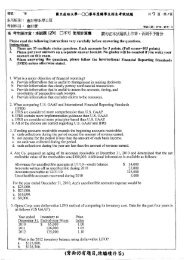Airport systems planning, design and management
Airport systems planning, design and management
Airport systems planning, design and management
Create successful ePaper yourself
Turn your PDF publications into a flip-book with our unique Google optimized e-Paper software.
Tactical Planning ( 執 行 計 畫 , 近 程 )• 上 承 策 略 計 畫 , 確 定 中 程 、 近 程 之 執 行 項 目 及 執行 方 式 Project Planning ( 專 案 計 畫 , 細 部 )• 上 承 執 行 計 畫 , 進 行 近 程 計 畫 中 之 各 單 項 之 界 定與 執 行 計 畫
機 場 計 畫 種 類 <strong>Airport</strong> system plan• 台 灣 民 航 發 展 之 研 究 計 畫• 南 部 國 際 機 場 第 二 階 段 場 址 評 估 報 告 / 82 年 6 月• 南 部 國 際 機 場 發 展 計 畫 / 82 年 6 月 <strong>Airport</strong> master plan• 中 正 國 際 機 場 主 計 畫 修 訂 規 劃 報 告 <strong>Airport</strong> project plan• 中 正 機 場 二 期 航 站 工 程
National <strong>Airport</strong> Planning 定 義 全 國 機 場 系 統 的 範 圍 確 定 全 國 機 場 系 統 的 宗 旨 與 目 標 敘 明 全 國 機 場 系 統 現 況 與 未 來 成 長 條 列 機 場 系 統 需 求 項 目 機 場 系 統 之 改 善 構 想 預 估 改 善 機 場 系 統 所 需 資 源 模 擬 不 同 改 善 方 案 之 成 效 與 資 金 需 求
Strategic plans 以 嚴 謹 系 統 的 方 法 分 析 目 前 處 境 與 未 來 發 展• SWOT : Strength, weakness, opportunity, threat A broad multidimensional view of the future The role played within a group of relatedairports Underst<strong>and</strong>ing the system is to bedeveloped 不 強 調 具 體 作 為 如 果 不 能 有 彈 性 、 與 master plan 一 樣 淪 為 表報 形 式 , 沒 有 意 義
Future uncertainties Flexible development• Minimize risk• Take opportunities Privatize airports• Rare regional, national <strong>planning</strong>• Corporate strategies for companiesoperation
Master Plans Presents the planners conception of theultimate development of a specific airport• Ultimate vision (e.g. 20 years)• Architectural/engineering development (notoperational concepts or <strong>management</strong> issues)• For specific airports (not for regional aviationsystem) Reactive : 被 動 應 付 環 境 Proactive : ( 趨 勢 ) 創 造 未 來 環 境(Orl<strong>and</strong>o/Sanford 機 場 為 例 )
– Normal procedures• Inventory existing conditions• Forecast future traffic• Determine facility requirements• Develop several master plan alternatives forcomparative analysis• Select the most acceptable <strong>and</strong> appropriatemaster plan– 死 板 的 計 畫 ( 死 抱 預 測 ) Dead-on-arrival– Uncertainty wrong ? Difficult ? Oropportunities
<strong>Airport</strong> Systems• Geographically– Regional networks– Metropolitan multiairport<strong>systems</strong>– National networks– International <strong>and</strong>intercontinentalnetworks• Functionally– Integrated cargonetworks– “cheap-fare” networks• Other– Number of passengers– Hubs– international/domestic– 通 常 政 府 定 義 的 機 場 分類 , 實 用 意 義 不 大 !• 政 府 無 力 有 效 執 行 「 實質 的 airport <strong>systems</strong>」• 在 privatize,commercialize 的 時 代 ,政 府 主 導 與 補 貼 已 經 無法 再 成 功
• An airport may be part of several <strong>systems</strong>• 政 府 對 機 場 系 統 的 劃 分 意 義 、 作 用 有 限• 政 府 與 機 場 系 統 關 聯 性 極 低• 政 府 規 劃 的 機 場 系 統 失 敗 案 例 屢 見 不 鮮○ 建 構 機 場 系 統 週 邊 投 資 缺 失 功 能 不 彰 長 期 補 貼 預算 不 足 棄 置 或 民 營 自 生 自 滅• 自 由 市 場 經 濟 導 向 產 生 的 機 場 系 統 ○ 民 營 機 場 公 司 或 地 方 政 府 主 導 National/regional <strong>planning</strong> of airport 愈 來 愈 罕 見 !• 取 而 代 之 : 以 全 球 佈 局 與 經 營 角 度 的 機 場 規 劃
The forecast is always wrong Reasons• Oil crisis(1970s), financial crisis(1990s),terrorism(2001), oil price(2007), new aircraft,airlines mergers/alliances, political changes, … 設 計 必 須 能 適 應 不 同 狀 況
Record for aviation forecasts covers• Cost estimation○ 超 過 ± 30% 很 平 常• overall levels of traffic○ 5-10 years error : 一 半 以 上 超 過 ± 20%○ Large forecasting errors are normal• Composition of traffic○ 更 不 準 Deregulation 影 響 至 鉅
Why ?
Implications for Planning• 好 的 計 畫 , 不 能 死 抱 著 預 測 值• 掌 握 所 有 的 變 因 及 可 能 性• Flexibility is essential○ 十 八 套 劇 本 ? 中 庸 之 道 ?○ 蚊 子 館 ? 啟 用 就 是 災 難 開 始 ?○ Range of forecasts (cf. single forecast)○ Decision analysis <strong>and</strong> simulation
Dynamic strategic <strong>planning</strong> Traditional <strong>planning</strong> + reality in 21st• Future uncertainties (forecast always wrong)• Flexible development strategy (deregulation)○ Minimize risks (competition)○ Taking advantage of opportunities• Privatize airports○ Rare regional, national <strong>planning</strong>○ Corporate strategies for companies operation
Dynamic Strategic Planning New vision cf. fixed vision (master/strategic plan) Compatible with master/strategic plan Orderly process of examination severalforecasts Shape future loads cf. reacting farecastspassively 經 常 預 測 不 同 運 量 預 測 的 可 能 發 展 經 常 討 論 面 對 不 同 發 展 的 應 變 方 案 時 間 花 在 「 應 變 」, 不 是 「 特 定 方 案 」
• The developments significantly influenced thetraffic at the airports.• <strong>Airport</strong> planners need to recognize this potential,<strong>and</strong> incorporate it into <strong>planning</strong> process.• ( 運 量 、 情 境 、 計 畫 ) 迭 代 連 動 , 沒 有 固 定 值• 總 結 : 就 像 下 棋○ Think many moves ahead○ Choose an immediate development to respond○ Rethinks the issues after what happens○ Adjust subsequent developments correspondingly
Dynamic strategic <strong>planning</strong> process/methods• Mombasa/Kenya 為 例 :○ 主 計 畫 : 國 內 航 站 + 國 際 航 站○ Dynamic 檢 討 : 直 接 來 自 歐 洲 或 自 首 都 轉 機 而 來○ 一 座 航 站 、 容 量 減 半 、 國 內 國 際 分 列 兩 側 、 中 間 帶 設施 共 用 、 運 量 成 熟 後 再 分 析 擴 建 策 略• 需 要 藉 助 computer model/analysis/simulation• Cost, flexibility, risk• SWOT 分 析 (SW 掌 握 現 況 、OT 創 意 未 來 )○ 吉 隆 坡 機 場 為 例
機 場 發 展 趨 勢 與 特 性24
因 地 制 宜 的 機 場 計 畫 國 情 、 地 域 、 文 化 性 差 異• 政 府 角 色• 民 間 企 業 參 與 度• 工 程 與 管 理 專 業 的 地 位• 機 場 定 位• 人 力 素 質 與 工 會 力 量 好 的 機 場 計 畫 ?• 何 謂 好 ? 見 仁 見 智• 此 地 好 機 場 ≠ 彼 國 好 機 場25
設 計 機 場 的 條 件• 飛 機 相 同 (Boeing, Airbus)• 規 範 相 同 (FAA, ICAO)• 觀 念 不 同 以 不 同 設 計 、 管 理 方 式 符 合 規 範26
Source: Neufville, Odoni, <strong>Airport</strong> <strong>systems</strong> <strong>planning</strong>, <strong>design</strong> <strong>and</strong> <strong>management</strong>, 200327
Source: Neufville, Odoni, <strong>Airport</strong> <strong>systems</strong> <strong>planning</strong>, <strong>design</strong> <strong>and</strong> <strong>management</strong>, 200328
Source: Neufville, Odoni, <strong>Airport</strong> <strong>systems</strong> <strong>planning</strong>, <strong>design</strong> <strong>and</strong> <strong>management</strong>, 200329
Source: Neufville, Odoni, <strong>Airport</strong> <strong>systems</strong> <strong>planning</strong>, <strong>design</strong> <strong>and</strong> <strong>management</strong>, 200330
Source: Neufville, Odoni, <strong>Airport</strong> <strong>systems</strong> <strong>planning</strong>, <strong>design</strong> <strong>and</strong> <strong>management</strong>, 200331
差 異 的 根 源• Who makes decisions-central authorities or pluralisticstakeholders• What is the decision-making process-directedautocratically? Negotiated among interest groups?• Which values <strong>and</strong> goals are most important-economicbenefits? Social values? Regional prestige?• What are the criteria for excellence-high profits? Goodservice? Beauty? Centralized Pluralistic (diversity) decisionmaking32
Development of airport system• 美 國 – 中 央 政 府 介 入 機 會 有 限○ FAA 只 能 support, encourage, confirm local decisions, butcannot impose its will• 法 國 – 遷 移 機 場 擴 建 機 場 - 無 公 聽 會 、 無 抗 議 示 威 Performance criteria• 從 什 麼 角 度 去 定 義 performance○ 宣 揚 國 威 ? 討 好 民 眾 ? 賺 錢 ? 福 利 ?• 誰 來 評 價 performance• 技 術 專 業 ? 外 行 領 導 內 行 ?33
Source: Neufville, Odoni, <strong>Airport</strong> <strong>systems</strong> <strong>planning</strong>, <strong>design</strong> <strong>and</strong> <strong>management</strong>, 2003 34
There is no single right answer• Respect, adapt to local values• 兩 個 機 場 的 比 較○ Staggered runway○ Paved area○ Parking vs. TGV○ 鼓 勵 vs. 抑 制 私 人 航 機○ 機 場 的 經 營 : 權 責 統 一 vs. 切 割 自 由 競 爭35
Source: Neufville, Odoni, <strong>Airport</strong> <strong>systems</strong> <strong>planning</strong>, <strong>design</strong> <strong>and</strong> <strong>management</strong>, 200336
Source: Neufville, Odoni, <strong>Airport</strong> <strong>systems</strong> <strong>planning</strong>, <strong>design</strong> <strong>and</strong> <strong>management</strong>, 200337
Source: Neufville, Odoni, <strong>Airport</strong> <strong>systems</strong> <strong>planning</strong>, <strong>design</strong> <strong>and</strong> <strong>management</strong>, 200338
















